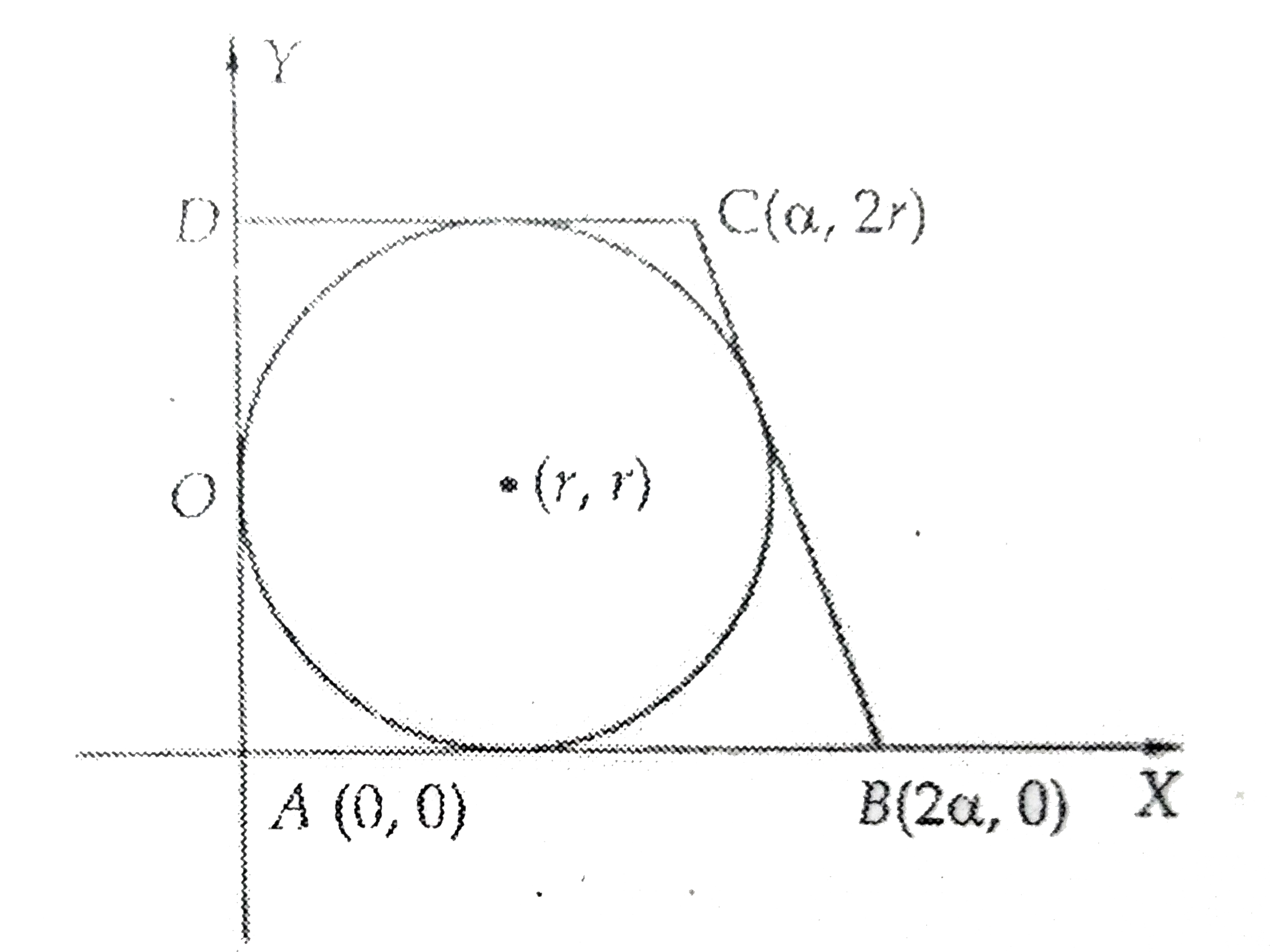Let ABCD be a quadrilateral with area 18 , side AB parallel to the side CD,andAB=2CD . Let AD be perpendicular to ABandCD . If a circle is drawn inside the quadrilateral ABCD touching all the sides, then its radius is a=3 (b) 2 (c) 32 (d) 1
3
2
3/2
1
The correct Answer is:B
Let CD=α. Then, AB=2α.
The equation of BC is
y=−2rα(x−2α)or,2rx+αy−4rα=0

It touches the circle (x−1)2+(y−r)2=r2
∴∣∣∣2x2+αr−4αr√4r2+α2∣∣∣=r
⇒(2r2−3αr)2=r2(α2+4r2)
⇒(2r−3α)2=(α2+4r2)⇒−12rα+9α2=α2⇒α=3r2
Now, Area of quadrilateral ABCD = 18
⇒12(AB+CD)x2r=18
⇒3αr=18
⇒αr=6⇒3r2=12[∴α=3r2]
⇒r=2
Topper's Solved these Questions
- CIRCLESBook:OBJECTIVE RD SHARMA ENGLISHChapter:CIRCLESExercise:Section-I (Solved MCQs)
Explore 1 Video
- CIRCLESBook:OBJECTIVE RD SHARMA ENGLISHChapter:CIRCLESExercise:Section II - Assertion Reason Type
Explore 12 Videos
- CIRCLESBook:OBJECTIVE RD SHARMA ENGLISHChapter:CIRCLESExercise:Chapter Test
Explore 53 Videos
- CARTESIAN PRODUCT OF SETS AND RELATIONS Book:OBJECTIVE RD SHARMA ENGLISHChapter:CARTESIAN PRODUCT OF SETS AND RELATIONS Exercise:Chapter Test
Explore 30 Videos
- COMPLEX NUMBERS Book:OBJECTIVE RD SHARMA ENGLISHChapter:COMPLEX NUMBERS Exercise:Chapter Test
Explore 58 Videos
Similar Questions
Let ABCD be a quadrilateral with area 18 , side AB parallel to the side CD,andAB=2CD . Let AD be perpendicular to ABandCD . If a circle is drawn inside the quadrilateral ABCD touching all the sides, then its radius is 3 (b) 2 (c) 32 (d) 1
View SolutionIf ABCD is a quadrilateral in which ABCD and AD=BC, prove that ∠A =∠B .
View SolutionA quadrilateral ABCD is drawn to circumscribe a circle. Prove that AB+CD=AD+BC
View SolutionA quadrilateral ABCD is drawn to circumscribe a circle. Prove that AB+CD=AD+BC
View SolutionA quadrilateral ABCD is drawn to circumscribe a circle. Prove that AB+CD=AD+BC
View SolutionA circle touches all the four sides of a quadrilateral ABCD . Prove that: AB+CD=BC+DA .
View SolutionIn the adjoining figure ABDC and DA is perpendicular to AB. Further, DC=7cm, CB=10cm and AB=13cm. Find the area of the quadrilateral ABCD.
View SolutionIn Figure, AB and CD are respectively the smallest and longest sides of a quadrilateral ABCD. Show that ∠A>∠C and ∠B>∠D
View SolutionIn Figure, ABCD is a cyclic quadrilateral whose side AB is a diameter of the circle through A, B, C, D. If (∠ADC)=1300, find ∠BAC
View SolutionIn Figure, ABCD is a quadrilateral and BE∣AC and also BE meets DC produced at E. Show that area of ADE is equal to the area of the quadrilateral ABCD
View Solution